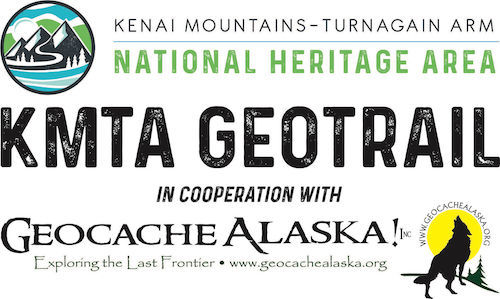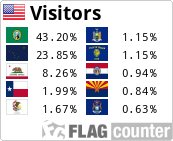About the KMTA GeoTrail:
Welcome to a geocaching trail exploring Alaska’s only National Heritage Area. In 2009, Congress designated the Kenai Mountains-Turnagain Arm (KMTA) region of Southcentral Alaska as a National Heritage Area (NHA). This designation formally recognizes the history of an area that has deeply shaped the legacy of Alaska and the nation. It is the history of the Alutiiq, Sugpiaq, and Dena’ina people—the original stewards and inhabitants of the Kenai Peninsula. It’s that of the Iditarod National Historic Trail, Alaska Railroad, Gold Rush, Seward Highway, and local industries that give KMTA its character. KMTA’s geographic footprint bridges Cook Inlet and Prince William Sound via mountains, glacial valleys, and productive rivers. Throughout this landscape are communities and stories that connect us to our past and future. It includes the small and vibrant communities of Bird, Indian, Girdwood, Whittier, Hope, Cooper Landing, Moose Pass, and Seward, and all the wilderness between them. As Alaska’s only National Heritage Area, KMTA aims to enhance, preserve, and share the region’s natural and cultural resources— in essence its heritage. Above all else, KMTA strives to foster pride of place and an enduring stewardship ethic for this special place. As you travel through the Heritage Area to complete this GeoTrail, we encourage to keep that stewardship ethic front of mind as you learn about and enjoy the richness of the region.
As you search for the geocaches making up this GeoTrail, you’ll be asked to complete a passport that qualifies you to purchase the KMTA GeoTrail Geocoin. For more information on the Passport and GeoTrail, please visit KMTA-GeoTrail.GCAK.org
KMTA field guide link: https://kmtacorridor.org/field-trip-guide/
The unique code word for this cache is found on the front of the logbook and/or on the inside of the container lid.
**Cell coverage warning: this location may have limited cell phone coverage (at least for data). It would be wise to download the cache information before arriving at GZ.**
KMTA GeoTrail #20: Seward's Woodlawn Cemetery
Visit Seward's first cemetery and the gravesite of one of its most influential original residents. With information from your visit, you'll be able to adjust your waypoint to find the cache container located nearby.
Deep snow is common here in winter, making it difficult to access the final hide location across snow berms along the road. The cache is hidden at ground level, and may not be accessible in deep snow.
When Seward was first founded it was squeezed between the area surrounding today's SeaLife Center and the current Jefferson Street (which was actually the sometimes raging Lowell Creek which created the outwash debris field that the town rests upon.) During the early days, the dearly deceased were planted all around the town, often in backyards. At one time Boulder Field (the gravel baseball field in town) and the land currently occupied by the hospital were once organized graveyards. With the ever-present issue of Lowell Creek flooding and the need to expand the town, the Woodlawn property was purchased by the city in 1916. This location provided a pleasant resting place out of town with good access. The gravesites in town were exhumed and relocated from the city to this site. Unfortunately, Salmon Creek proved as fickle as Lowell Creek and it caused a rise in the water table making the Woodlawn site unsuitable for future burials and problematic for many that were already buried there. By the mid 1920’s the Woodlawn cemetery was decommissioned and many of its inhabitants were again moved, this time to the current location behind the City Chamber of Commerce, where hopefully they can finally rest in peace.

Sign at northwest corner of Woodlawn Cemetery.
Your first stop is at a relatively modern-looking gray marble tombstone, in the shape of a spire. The first name on this tombstone of the person buried here is Mary, and she is undoubtedly Seward's most notable early resident. Here's a part of her claim to fame, as presented on the Society of Architectural Historians' website regarding Seward:
In 1902 a group of Seattle investors headed by John E. Ballaine surveyed a course for a railroad to interior Alaska. Resurrection Bay, cherished as the northernmost ice-free port, was selected as the terminus. Although his partners never thought that the site would be more than a temporary construction camp, Ballaine saw its potential as a permanent city. In 1903, his agents negotiated with Mary _____, a Native who was the only resident of the projected townsite. She filed a homestead claim and then Ballaine bought her property, securing title to the townsite. He laid out the new town in a grid plan and named it Seward.
Once you've found Mary's tombstone, you'll need to process the information found on that marker to complete the final coordinates as listed below. This information will take you to the final cache location, around 260 feet away.
Final Coordinates: N60 09.2AB W149 24.CDD
Where A = 1.5 times the total number of letters in Mary's last name
Where B = 1st digit of Mary's age at her time of death
Where C = Total number of the letter L in Mary's last name
Where D = 2nd digit of Mary's age at her time of death

This cache is maintained by local Alaskan geocacher NorthWes.
Please contact him with any questions or maintenance requests.
